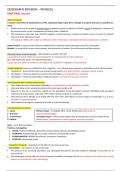Summary
Need a condensed in-depth summary? Hazards revision...
- Course
- Institution
- Book
In-depth summary of the hazards unit, revision which helped me achieve an A, almost A*. Save hours worth of reading by having it all neatly presented here...
[Show more]




